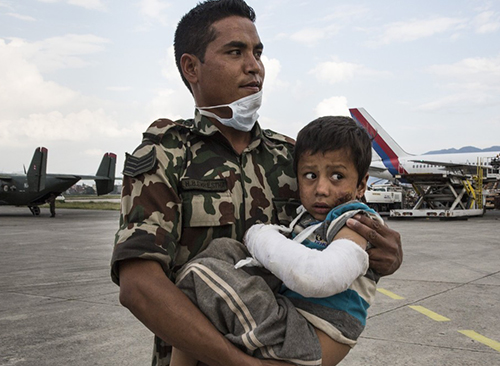
Rescue, Relief and International Aid
About 90 percent of soldiers from the Nepalese Army were sent to the stricken areas in the aftermath of the earthquake under Operation Sankat Mochan, with volunteers mobilized from other parts of the country. Rainfall and aftershocks were factors complicating the rescue efforts, with potential secondary effects like additional landslides and further building collapses being concerns. Impassable roads and damaged communications infrastructure posed substantial challenges to rescue efforts. Survivors were found up to a week after the earthquake.
As of 1 May 2015, international aid agencies like Médecins Sans Frontières (Doctors Without Borders) and the Red Cross were able to start medically evacuating the critically wounded by helicopter from outlying areas, initially cut-off from the capital city, Kathmandu, and treating others in mobile and makeshift facilities. There was concern about epidemics due to the shortage of clean water, the makeshift nature of living conditions and the lack of toilets.
Emergency workers were able to identify four men who had been trapped in rubble, and rescue them, using advanced heartbeat detection. The four men were trapped in up to ten feet of rubble in the village of Chautara, north of Kathmandu. An international team of rescuers from several countries using FINDER devices found two sets of men under two different collapsed buildings.
Volunteers used crisis mapping to help plan emergency aid work. Public volunteers from around the world added details into online maps. Information was mapped from data input from social media, satellite pictures and drones of passable roads, collapsed houses, stranded, shelterless and starving people, who needed help, and from messages and contact details of people willing to help. On-site volunteers verified these mapping details wherever they could to reduce errors. First responders, from Nepali citizens to the Red Cross, the Nepal army and the United Nations used this data. The Nepal earthquake crisis mapping utilized experience gained and lessons learned about planning emergency aid work from earthquakes in Haiti and Indonesia.
Reports are also coming in of sub-standard relief materials and inedible food being sent to Nepal by many of the foreign aid agencies.
A United States Marine helicopter crashed on 12 May while involved in delivering relief supplies. The crash occurred at Charikot, roughly 45 miles (72 kilometers) east of Kathmandu. Two Nepali soldiers and 6 American soldiers died in the crash.
UNICEF appealed for donations, as close to 1.7 million children had been driven out into the open, and were in desperate need of drinking water, psychological counsel, temporary shelters, sanitation and protection from disease outbreak. It distributed water, tents, hygiene kits, water purification tablets and buckets. Numerous other organisations provided similar support.
India was the first to respond within hours, being Nepal’s immediate neighbour, with Operation Maitri, which provided rescue and relief by its armed forces. It also evacuated its own and other countries’ stranded nationals. The United Kingdom has been the largest bilateral aid donor to Nepal following the earthquake. The United States, China and other nations have provided helicopters as requested by the Nepali government.
On 26 April 2015, international aid agencies and governments mobilised rescue workers and aid for the earthquake. They faced challenges in both getting assistance to Nepal and ferrying people to remote areas as the country had few helicopters. Relief efforts were also hampered by Nepalese government insistence on routing aid through the Prime Minister’s Disaster Relief Fund and its National Emergency Operation Center. After concerns were raised, it was clarified that “Non-profits” or NGOs already in the country could continue receiving aid directly and bypass the official fund. Aid mismatch and supply of “leftovers” by donors, aid diversion in Nepal, mistrust over control of the distribution of funds and supplies, congestion and customs delays at Kathmandu’s airport and border check posts were also reported. On 3 May 2015, restrictions were placed on heavy aircraft flying in aid supplies after new cracks were noticed on the runway at the Tribhuvan airport (TIA), Nepal’s only wide-body jet airport.




